|
Presents Steam Engine Valve Gear on the Computer Introduction |
With the introduction of the reciprocating steam engine for use in stationary, marine, locomotive and other services, non-power developing scale models were also produced to be used as educational aids to demonstrate the operation of various components of full scale engines. A particular purpose of these models was to demonstrate the operation of an engines valve gear. One such hand powered model is illustrated in the images below. Its length being approximately 15 inches.
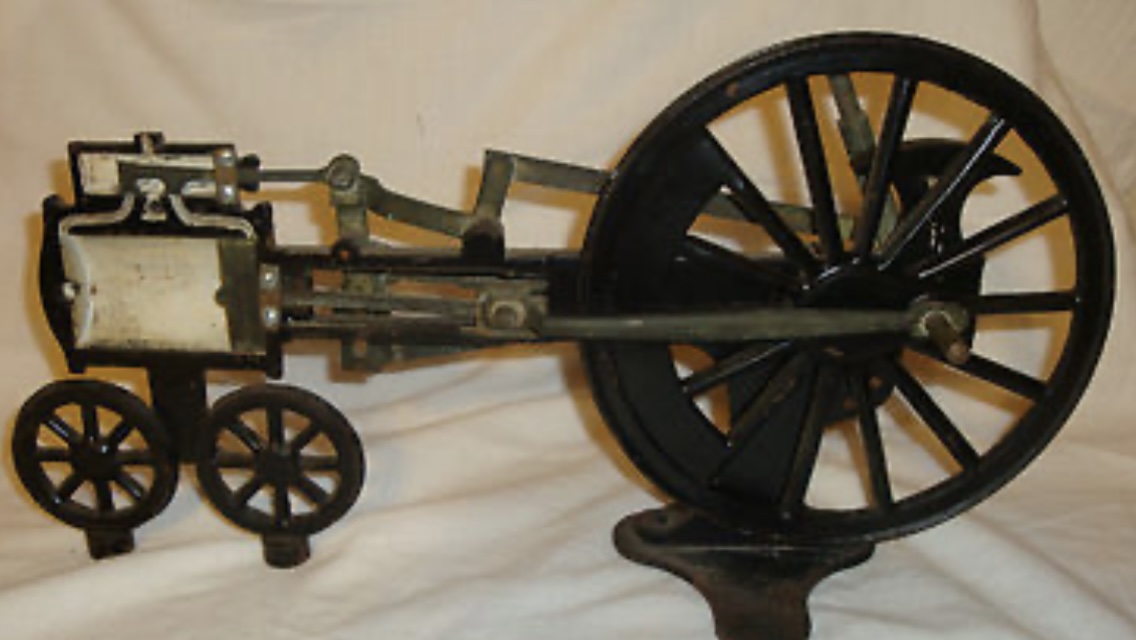
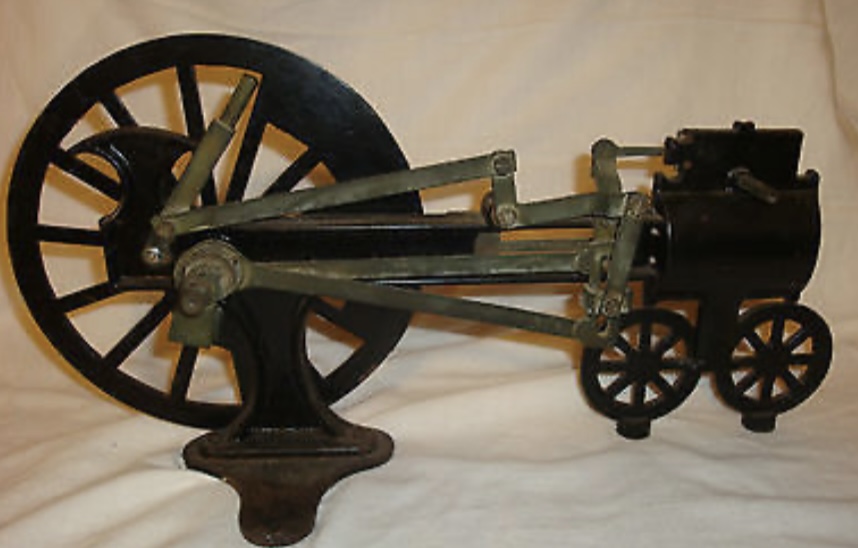
Access to these artifacts of industrial education has been limited due to their specialized nature and use that resulted in their production in limited quantities. Models that do exist to this day will generally be discovered in the collections of railway or industrial heritage museums. Although these models do have historical importance, their practical use is limited by the fact that they demonstrate only one type of steam engine and valve gear.
Fortunately for those living in the Twenty-first Century and interested in studying the operating principles of the steam engine, and in particular the steam locomotive, the late Charles J. Dockstader (d. 2011) had embarked on a project beginning in 1986 to produce a series of computer programs that provide a graphical motion simulation of numerous steam engine valve gears. Below is a computer display image captured when running Mr. Dockstader's program that demonstrates an outside admission type Stephenson valve gear.
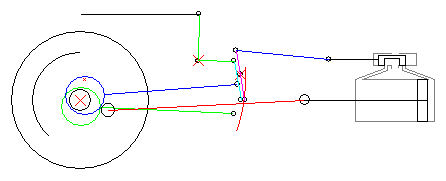
The series of "Steam Engine Valve Gear on the Computer" programs as of 2010 now includes over 60 valve gear variations. Mr. Dockstader graciously made the software available to future generations by placing it in the public domain as freeware. There are no restrictions on the non commercial use of the software.
The complete series of Windows® compatible programs by Mr. Dockstader have been combined by the Lake Forest Live Steamers Railway Museum into a single compressed "zip" file.
The following are step by step instructions for down loading the zip file and running the programs on a Windows® compatible computer:
1. Create a new folder on your computer in a location and folder name of your choice. The folder name typically being "valvegear" or similar.
2. Click on the link in step 8 then click on "save as" then navigate to the folder on your computer previously created in step 1 then click "save."
3. Once the zip file has finished downloading open the previously created folder using a file utility or viewing program on your computer such as Windows® Explorer, My Computer, etc., etc. The compressed file named "valgr10.zip" should appear within the folder.
4. Unzip or extract the files within "valgr10.zip" to the same folder using a file extraction utility on your computer. Right clicking on the "valgr10.zip" file may bring up a menu that includes a selection to "extract all" then left click on "extract all".
5. Once the file extraction process is complete open the newly created not zipped folder named "valgr10" and search for the file named "VGStart.exe" then create a short cut to the file, then place the short cut on the desktop of your computer or other location of your choice. Right clicking on the "VGStart.exe" file may bring up a menu that includes a selection to "send to" then left click on "Desktop (create shortcut)".
6. The short cut is then used to run the "VGStart.exe" file that in turn provides a "valve gear selection menu" window used to select and run the various valve gear simulation programs. The image below illustrates this window.
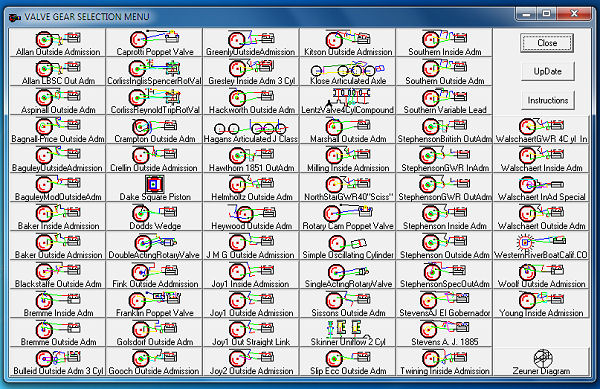
7. It is recommended that the user click the "Instructions" button near the top right of the the valve gear selection menu window thereby opening an instruction document that explains many of the features and functions of the various programs.
8. Steam Engine Valve Gear on the Computer zip file (45 MB when extracted)
Depending on the security settings of your computer, various computer permissions may have to be granted, approved or changed in order to down load and or run the executable files that make up the "Steam Engine Valve Gear on the Computer" programs. A typical computer file or program security window that may appear is illustrated below. Clicking "Run" should start the program running.
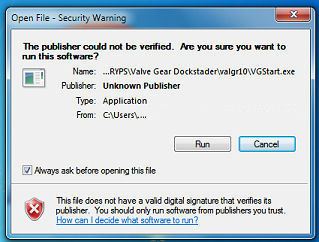
The various instructions for "Steam Engine Valve Gear on the Computer" are normally accessed when running an individual valve gear program or the valve gear selection menu program. The following links are provided to PDF documents that have been prepared from the original instruction and update document files.
MS-Windows® Instructions of 2007
Individual Valve Gear Special Instructions of 2010
Update Log as of June 12, 2010
Using Mr. Dockstader's program a PDF document has been produced consisting of a series of Dockstader "oval diagrams," also known as valve ellipses, of a typical Walschaert inside admission valve gear. Pages 2 through 17 represent different reverse lever positions beginning with the reverse lever in centered position and ending with the reverse lever in full forward position. Sequentially viewing pages 2 through 17 in one at a time page view mode presents a slide show of the valve ellipse changes that occur as the reverse lever is repositioned. The last page of the PDF includes explanation notes relating to the valve ellipse diagrams and the associated valve events and cylinder events.
PDF File of Valve Ellipse Diagrams for Walschaert Inside Admission Valve Gear
The image below shows a valve ellipse diagram from the book Steam Engine Indicators and Valve Gears by L. V. Ludy published in 1918.
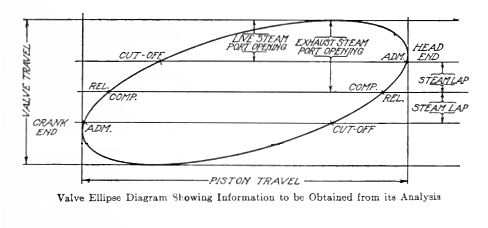
For additional locomotive valve gear information see the LFLSRM Recommended Technical and Historical Reading List at this link.
NOTICE: Any and all information, data, images or drawings published as part of this web site have been prepared solely for the noncommercial amateur engineering use of designers, builders, maintainers or operators of one-eighth scale model railway track, locomotives or rolling stock. It has been compiled from information sources believed by Lake Forest Live Steamers Railway Museum Incorporated and any author credited to be competent. However, recognizing that each component of any system must be designed and installed to meet the particular circumstances, Lake Forest Live Steamers Railway Museum Incorporated and any author credited assumes no responsibility or liability of any kind in connection with the information, data, images or drawings published as part of this web site that are used in any way by any person or organization and makes no representations or warranties of any kind hereby.